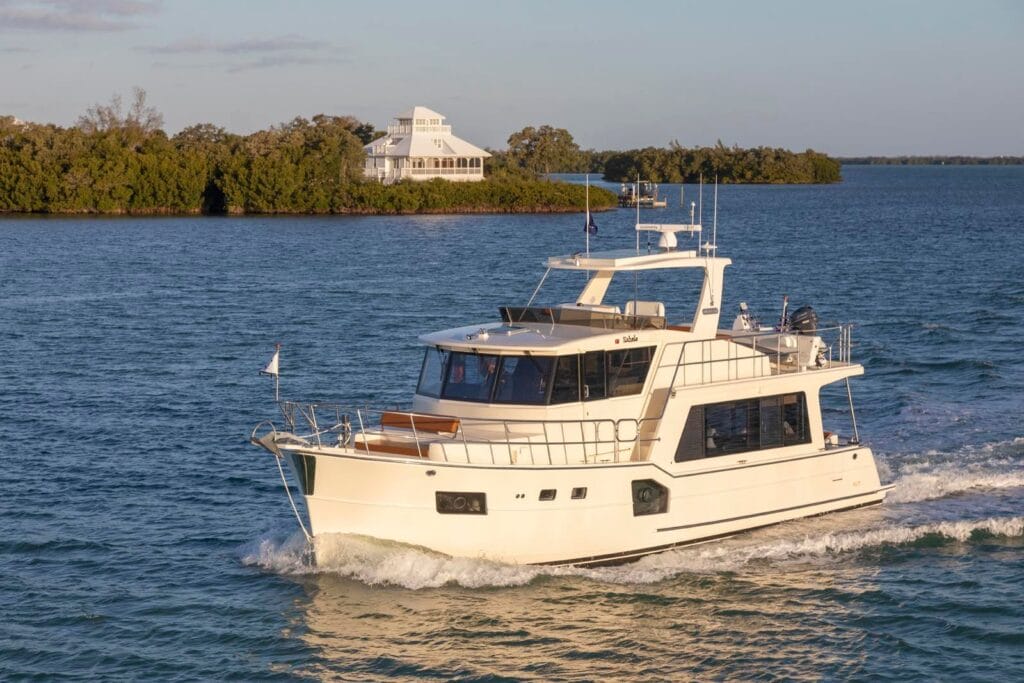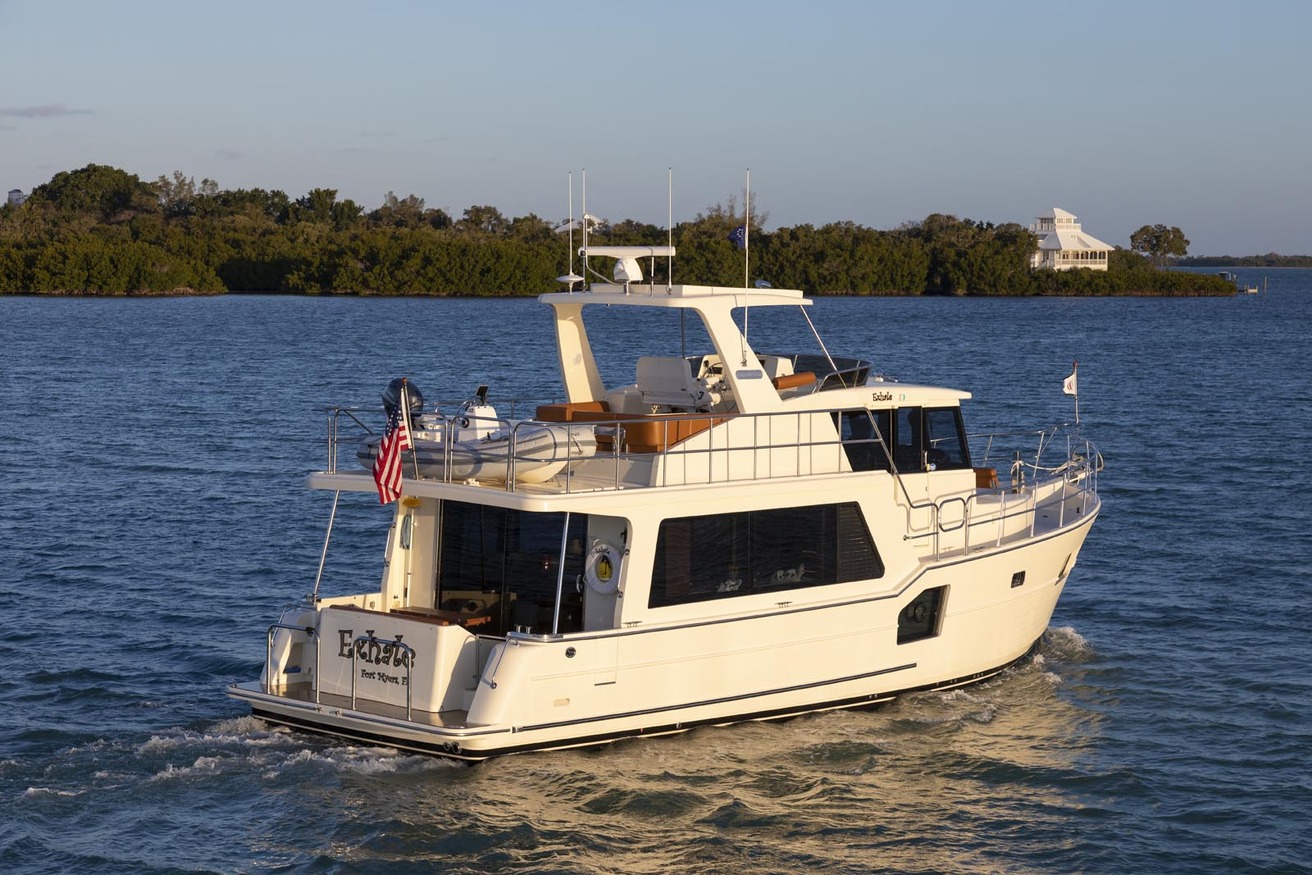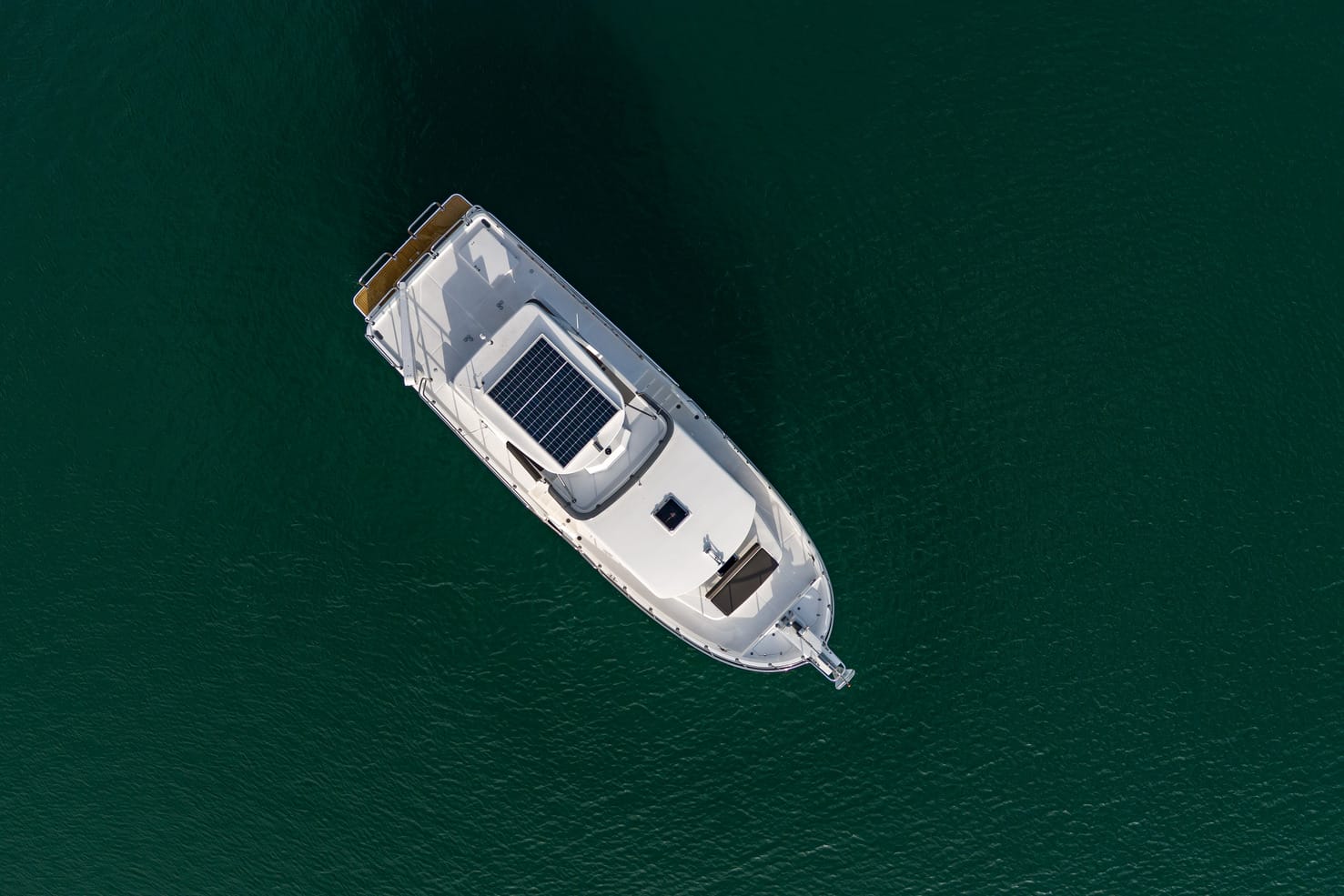Whether or not you’re legally required to name a boat depends on how and where it’s registered. In the U.S., federally documented vessels through the Coast Guard are required to have a name and a hailing port displayed on the hull, typically on the stern. This requirement usually applies to boats over five net tons, which includes most cruising yachts. Smaller recreational vessels registered only at the state level typically don’t have a legal obligation to carry a name, although many owners still choose to name them for identification or tradition. If you’re registering your yacht under a foreign flag—like the Cayman Islands or Malta—there are additional naming rules and restrictions that apply, including name uniqueness and sometimes limitations on language or offensive terms.
From our side as builders, we’re often involved in the final stages of name application—whether it’s installing vinyl transom lettering, carving the name into a nameplate, or applying it under clearcoat for a seamless finish. We coordinate name placement around the design of the hull and the required specs from documentation authorities. Even when not legally required, naming your boat helps with safety communication, navigation systems, and insurance documentation. For many of our clients, it also becomes a personal touch that connects them to the vessel—turning a high-performance hull into something with identity and meaning.

Legal Naming Requirements for Boats and Yachts
When Is Naming a Boat Legally Required?
For federally documented vessels in the U.S., naming a boat is a legal requirement under Coast Guard regulations. Documentation applies to boats measuring five net tons or more—typically around 26 feet in length or greater—and used for either recreational or commercial purposes. These vessels must display a name and a hailing port permanently affixed to the hull. Names are submitted during the documentation process and must be approved for uniqueness and appropriateness.
Smaller recreational boats registered at the state level generally don’t have a legal obligation to display a name. That said, many owners choose to name them for identification, personalization, and tradition. The distinction between federal documentation and state registration plays a central role in determining whether a name is required by law.
State vs. Federal Naming Requirements
State-registered vessels often only require registration numbers and validation stickers—no name needed. States like Arizona or Colorado, where water access is limited, may not enforce naming customs at all. However, if a boat is both state-registered and federally documented, it must comply with federal naming and display rules.
In some cases, vessels operating commercially may still be registered at the state level, depending on size and purpose. But once a vessel is documented federally, the naming and hailing port become mandatory identifiers.
International Yacht Registration Naming Rules
Registering a yacht under a foreign flag—such as the Cayman Islands, Marshall Islands, or Malta—introduces additional rules. These jurisdictions typically require names to be unique within their respective registries and may restrict language or terms deemed offensive, political, or misleading.
Port of registry is also a legal requirement, and both the yacht’s name and its homeport must be displayed clearly on the hull. Many international registries require advance approval of the chosen name, along with backup options in case of duplication.
Boat Documentation, Registration, and Identification
Why Boat Names Are Displayed
Displaying a boat name serves practical and legal purposes. It allows authorities to quickly identify a vessel, both visually and electronically, especially in emergency situations. Names are used in marine radio communications, AIS (Automatic Identification Systems), and documentation systems that track ownership and compliance.
The name, paired with the hull identification number (HIN) or documentation number, creates a complete identity for the vessel across all records. This is critical for customs clearance, insurance, and cross-border navigation.
Hailing Port and Name Display Guidelines
For documented yachts, the name and hailing port must be clearly marked on the exterior hull—typically the transom—in block letters no less than four inches in height. The markings must be durable, visible, and affixed in a permanent manner, whether through paint, vinyl, or carving.
The hailing port must include a city and state (for U.S. documentation) or the recognized port of registry if flagged internationally. Both the name and port must appear together on the stern, though some owners also choose to place the name on the sides or superstructure for aesthetic or visibility reasons.
Naming During the Documentation Process
Boat names are submitted as part of the application for federal or international documentation. If a name is already in use or restricted, the registering authority will require alternate options. Once approved, the name is tied to the vessel’s record and must appear on official paperwork.
Renaming a vessel after purchase or during a major refit is allowed but requires re-documentation. This may involve updating Coast Guard records, repainting or relettering the hull, and notifying insurance or customs agents. For vessels changing flags, the new registry may impose additional name approval steps.
Naming Traditions, Customs, and Superstitions
Maritime Superstitions About Naming or Renaming
For centuries, sailors have treated boat naming as a serious ritual. There’s a long-standing superstition that renaming a boat without the proper ceremony brings bad luck. Some owners perform “denaming” ceremonies to symbolically purge the old identity before introducing a new one.
These customs, while not legally required, are still respected by many owners—especially in the luxury yacht community. It’s common to mark the occasion with a formal christening that involves champagne, blessings, or even poetic dedications.
Naming Trends in Yacht Ownership
Owners often choose names that reflect personal values, family heritage, or travel aspirations. In the custom yacht segment, we see everything from initials and mythological references to geographic nods and inside jokes. Unique names not only express personality but can also increase a yacht’s resale appeal and memorability in the marina.
Yachts used for charter may be named with branding in mind—something aspirational, elegant, or easily recognized by guests and brokers alike.
Builder Involvement in the Naming Process
We’re frequently involved in the visual execution of a yacht’s name. That includes applying transom lettering, engraving nameplates, or coordinating custom signage. We also consult on placement and sizing to ensure compliance with registry rules and design harmony.
During major refits or repaints, naming updates become part of the scope. We carefully mask or remove existing markings, prepare the surface, and reinstall the updated name as a seamless part of the yacht’s finish. Because name display is both functional and aesthetic, we treat it with the same precision as any other visual detail.

Compliance and Ownership Implications
Boat Name as a Legal Identity
A yacht’s name serves more than a decorative or sentimental function—it acts as part of its legal identity. When a vessel is documented or registered, the name is included in its official records, making it critical for insurance policies, title documentation, and liability tracking. In the case of ownership disputes or marine insurance claims, a clearly registered vessel name helps confirm the vessel’s identity and ownership chain.
Boat names are also referenced in contracts of sale, charter agreements, and customs declarations. Whether entering foreign ports or engaging in cross-border trade, having a consistent, recorded name simplifies legal and operational processes. In commercial or charter service, a name becomes a unique identifier for regulatory bodies and clients alike, ensuring accurate assignment of operational records and credentials.
Trademark and Name Availability Issues
Just like businesses or products, yacht names can run into legal trouble if they conflict with existing trademarks or copyrighted terms. While most registries don’t check for trademark conflicts automatically, using a name that’s already protected could result in legal issues—especially if the yacht will be publicly chartered or promoted.
To avoid problems, many owners consult trademark databases and marine registries to check name availability in advance. Some international registries also publish searchable name indexes for this purpose. When selecting a name, it’s best to choose something unique, non-generic, and unlikely to cause confusion with well-known brands or vessels.
Implications of Not Naming a Boat
While not every vessel is required to have a name, omitting this step can create administrative complications. Insurance providers often ask for a name on policy documents. Customs agents and harbor authorities may also rely on vessel names for identification, especially in countries where hull numbers or documentation numbers are less familiar.
Without a name, a vessel may face delays or added scrutiny during inspections, port entries, or emergency communications. In short, even if naming isn’t mandated by your local registry, it’s considered best practice across the industry—for both compliance and convenience.
Practical Reasons to Name Your Yacht
Communication, Safety, and Navigation
A named vessel is far easier to identify in both everyday and emergency situations. In distress calls, a name provides immediate clarity for search and rescue efforts. Similarly, on AIS (Automatic Identification System), vessel names are broadcast along with other details to nearby boats and coastal stations.
Communicating with harbormasters, marinas, or maritime authorities becomes more efficient when a clear vessel name is used. It also helps avoid confusion in busy channels or anchorages, where numeric identifiers may be overlooked or misheard. For international travel, a properly named yacht can smooth the process of security checks, customs declarations, and clearance procedures.
Branding, Identity, and Emotional Connection
For many owners, naming a yacht is a chance to express personality, heritage, or lifestyle. Whether the name is inspired by a loved one, a favorite place, or a personal mantra, it becomes part of the vessel’s identity. This emotional connection adds depth to ownership and often plays a role in the pride owners take in maintaining their boats.
From a design standpoint, name graphics and lettering contribute to the visual impact of the transom or hull. Custom fonts, colors, and finishes can reflect the style of the vessel or the tone of its name—whether playful, classic, or commanding. In resale or charter markets, a memorable name can help the vessel stand out, support marketing efforts, and even enhance perceived value.
Why the Name Matters More Than You Think
In yacht building, the name is one of the few elements that ties together legal status, visual identity, and owner sentiment. It’s a bridge between formality and personalization—anchoring the vessel not just in records and regulations, but also in the heart of the person who commissioned it. That’s why we approach name selection and application with the same care we apply to hull design, system integration, and fine woodworking. It’s a detail that carries more weight than most realize—and it’s one that lasts the lifetime of the yacht.

Contact Us
At North Pacific Yachts, we’re here to make your journey to owning the perfect yacht seamless and enjoyable. Whether you’re looking for expert guidance on model specifications, insights into custom build options, or simply need a few questions answered, our team is ready to assist. With years of experience in yacht building, we’re dedicated to understanding your unique vision and helping you navigate the entire process with ease. Reach out to us by email at info@northpacificyachts.com for personalized responses to all your inquiries.
If you’d prefer a conversation, we invite you to give us a call at 1-877-564-9989. Speaking directly with our experienced team can provide immediate answers and professional insights into everything from specific build features to delivery timelines. At North Pacific Yachts, your satisfaction is our top priority, and we’re here to ensure you’re confident and informed at every step of your yacht ownership journey.
See our models here:
Related Posts
How Much Do Boat Builders Make?


